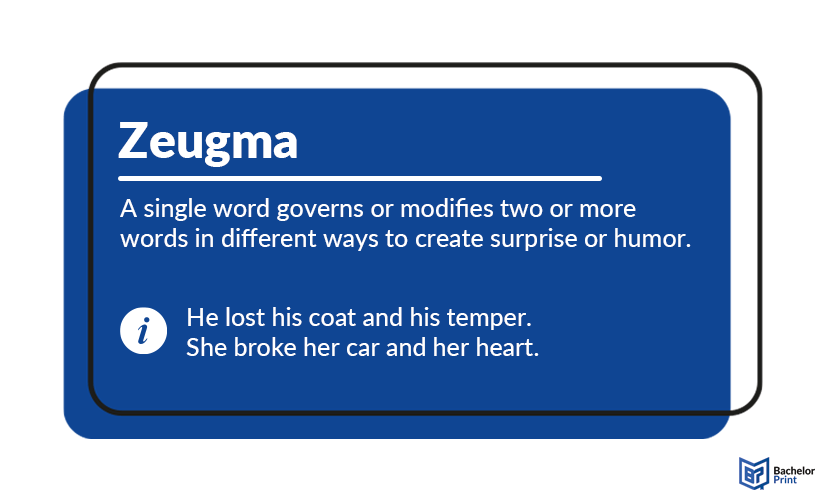
When I went out this morning, I first lost my keys and then my nerves. Sentences like this make the reader pause and reread, as they don’t expect the conjunction between the literal and figurative meanings—a hallmark of zeugma. While this stylistic device is rarely used in academic writing outside of literary analysis, it’s a valuable rhetorical device to understand. This article explains the zeugma, its purposes, and types, and provides numerous examples.
Definition: Zeugma
A zeugma, pronounced “zoog-muh” and also called syllepsis, is a figure of speech that links one main word, usually a verb, to two or more parts of a sentence. Typically, one of the linked words or phrases fits naturally to the yoke (=link), while the other creates an unexpected twist—often using an idiom or saying. This surprising combination adds a touch of literary finesse and often brings humor to the sentence.

- ✓ Free express delivery
- ✓ Individual embossing
- ✓ Selection of high-quality bindings
Examples
The following examples of common zeugmas may give you a better idea of this stylistic device and its use.
Use and purpose
Zeugmas can have different purposes depending on the usage.
- It can be used to flourish a text. The unconventional connection between two words makes the reader pause for a moment and read the sentence again.
- It can also stress or emphasize a connection the reader might not be aware of at first. This happens most often when a rather insignificant event is connected to a one with more weight.
In most cases, a zeugma is used to lighten a situation by opposing two contrasts. This brings a comedic effect and sense of drama into it, that gets stronger, the stronger the contrast is.
Note: While a zeugma does shorten sentences because of the yoking, it should never be used for this purpose solely. Using a it where it serves no literary duty causes confusion and seems irritating. Even if you use zeugmas correctly, you should still apply it very sparingly in your writing, for it loses its surprising effect when used too often.
Create a zeugma
Creating a zeugma is not all that difficult. The following four steps show you, how you can create one yourself.
1. At first, you need to be clear about the feeling you want to create. If you want the sentence to be humorous, you should use a contrast or a figure of speech. If you wish to add weight to a situation, turning it a little symbolic, connect a minor event to a bigger, maybe not physical one.
2. Next, you have to pick a governing word, that suits your situation.
3. This governing word then has to fit one of the words logically or in a literal sense, while the other one is a mental image or saying.
4. Lastly, you need to decide on the order of the governed words. Usually, in zeugmas, the logic word comes before the figurative one. However, if you want to create even more humor and finesse, you can also put the figurative word first, causing the reader to stumble over the logic one at the end.
Syllepsis
In most cases, syllepsis is used as a synonym for zeugma. There are, however, some people who prefer to differentiate the two figures of speech. Both of them refer to one word governing two or more others, but the zeugma focuses on the semantic aspect, the meaning of the phrase. The focus of the syllepsis lies on grammar, meaning that only one word fits the governing one in a grammatically correct way.
The zeugma here relies on the idiom of breaking someone’s trust as a figure of speech, while the vase is an object that can literally break into pieces. In the case of this syllepsis, the grammatically correct version would be “I study not at all.” As the two sentences became linked for the syllepsis, the verb “studies” is only correct for the first part of the sentence but used for both of them.
Types of zeugma
The easiest way to further describe and differentiate the zeugma in the English Language is by describing where the governing word is located in the sentence.
Prozeugma: The governing word is located in front of the governed words and mostly focuses on the objects the verb is referring to.
Mesozeugma: The governing word stands between the governed words and focuses on the people acting out what the verb says.
Hypozeugma: The governing word follows the governed words, meaning that the sentence is formed in a passive voice.
Furthermore, there is the special case of the diazeugma, where one subject governs multiple subsequent verbs. This type is typically used in sports commentary, and is thus also called “play-by-play”.
in Your Thesis
FAQs
In general, zeugma and syllepsis can be used as synonyms. There are people, however, who say that zeugma refers to when the governing word suits only one of the governed words semantically, while in the case of a syllepsis, only one governed word suits it grammatically.
No, a zeugma is most likely grammatically “incorrect,” since it is a play with words that is meant to be incorrect. A zeugma wants the reader to stumble over it and create a humorous effect, which is caused by linking words that actually do not fit in the same context.
Zeugmas can be everywhere once we find out how to spot them.
For example, in the “Lion King”, in Scar’s song “Be prepared,” he sings “Yes, my teeth and my ambitions are bared.”
If you want a more literary example, in chapter 43 of Jane Austin’s “Pride and Prejudice,” she wrote “Yet time and her aunt moved slowly,” which is also a zeugma.
